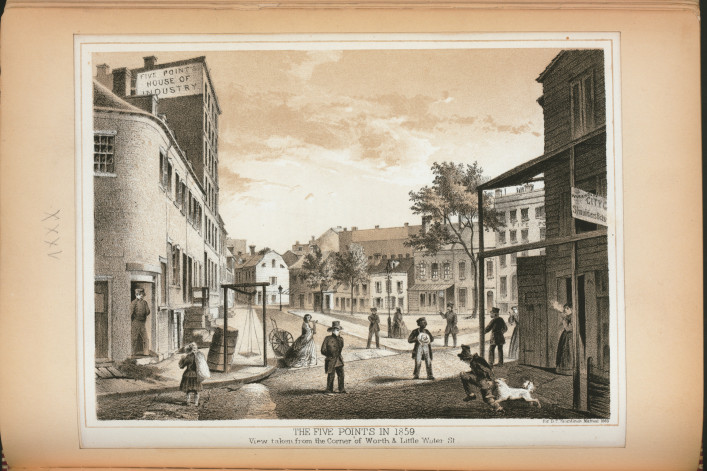Densely crowded cities and their Five Points-style housing are breeding grounds for epidemics

New York City's Five Points neighborhood in 1859.
If you’ve seen the Cinemax series The Knick, which takes place in a grimy turn-of-the-century Manhattan where illness thrives under filthy and crowded living conditions, it should come as no surprise that cities have historically been incubators for epidemics. A recent article in The Atlantic explores the toll that urban living took on public health during the 1800s—and how that history relates to recent scares about the Ebola and Zika viruses.
In 2014, when an American doctor who had treated Ebola patients in West Africa came down with the deadly virus upon returning to his home in Manhattan, many New Yorkers reacted fearfully. Breathless news reports tracked all the spots he’d visited throughout the city before his diagnosis, and those who had been at the same spots as the doctor wondered whether Ebola could be contracted through bowling balls. He later wrote in a personal essay that he felt the media had cultivated hysteria and politicians unfairly excoriated him.
Given the seriousness of illnesses like Ebola, it’s understandable that New Yorkers felt a bit panicked, but according to The Atlantic piece, “cities like New York may now appear to be largely washed clean of their past.” Today, thanks to housing regulations that vastly improved the unsanitary conditions that bred disease, it’s much more difficult for epidemics to spread here.
Back in 1832, though, it was a different story. A cholera epidemic killed 3,515 New Yorkers and sent the wealthy fleeing from the city. (Another outbreak followed in 1849.) These crises revealed how fast sickness could spread, particularly in poor and densely crowded neighborhoods like the area then known as Five Points, a slum whose dangerous conditions were in part exposed by Jacob Riis in How the Other Half Lives.
The book, the article notes, helped pave the way for 1901’s Tenement House Act, which made illegal the construction of buildings that lacked proper ventilation, plumbing, and fire protection—all elements of the kind of housing in Five Points that encouraged epidemics. (So your apartment now may be tiny, but at least it has an indoor toilet and windows.)

In other parts of the world, though, urban dwellers are not so fortunate. Five Points-style slums are hardly relics. In fact, in some cities in countries like India, Guinea, Sierra Leone, and Liberia, populations are exploding, and with them, neighborhoods with treacherous crowding and poor sanitation, thanks to the lack of Tenement House Act-style housing regulations. Culture plays a role, too—in addition to close quarters allowing for the easy transmission of Ebola from person to person, some West African traditions involve the bathing of corpses, from which the disease can also spread.
The rise of the Zika virus is similarly linked to urbanization. The mosquito that transmits the illness is attracted to standing water, which is prevalent in Latin American slums—home to 113 million people—where residents store water in buckets and tanks due to a lack of proper plumbing.
Despite the risks to public health, mass movement to urban centers is on track to continue: in 2014, the United Nations reported that by 2050, 66 percent of the world’s population will live in cities. Mega-cities—those with populations of over 10 million—will also become more prevalent. Mumbai is one of them, and has a slum called Dharavi that's seven times more densely-populated than Five Points was. The past, then, is unfortunately, the present for many, and more epidemics could be in the offing.
You Might Also Like
























